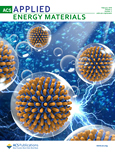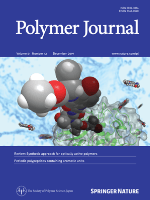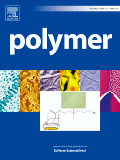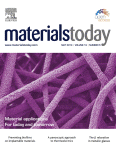
Materials Today Advances
Scope & Guideline
Elevating research visibility in cutting-edge materials science.
Introduction
Aims and Scopes
- Advanced Material Synthesis and Characterization:
Research on novel methods for synthesizing and characterizing advanced materials, including nanomaterials, composites, and 2D materials, which play a crucial role in enhancing material performance. - Materials for Energy Applications:
Focus on materials designed for energy production and storage, such as batteries, supercapacitors, and solar cells, aiming to improve efficiency and sustainability. - Biomaterials and Medical Applications:
Exploration of materials used in medical applications, including drug delivery systems, tissue engineering, and diagnostics, emphasizing their biocompatibility and effectiveness. - Smart and Functional Materials:
Investigation of materials that respond dynamically to environmental stimuli, such as hydrogels and shape-memory polymers, which have broad applications in robotics and adaptive systems. - Environmental and Sustainable Materials:
Research on materials that contribute to sustainability, including biodegradable polymers and environmentally friendly manufacturing processes, aimed at reducing ecological impact. - Computational Materials Science:
Utilization of computational techniques to predict material properties and behaviors, facilitating the design of new materials and improving existing ones.
Trending and Emerging
- Additive Manufacturing and 3D Printing:
There is a growing interest in additive manufacturing techniques, including the development of new materials and methods for 3D printing, which are revolutionizing production processes in various industries. - Nanotechnology and Nanomaterials:
The use of nanomaterials is on the rise, particularly in applications related to drug delivery, electronics, and energy storage, due to their unique properties and potential to improve performance. - Machine Learning and Data-Driven Materials Design:
The integration of machine learning approaches in materials science is trending, facilitating accelerated discovery and optimization of new materials through computational techniques. - Biomimetic and Bioinspired Materials:
Research focusing on materials inspired by biological systems is gaining momentum, particularly for applications in medicine and materials engineering, enhancing functionality and performance. - Smart Textiles and Wearable Technologies:
Emerging themes include the development of smart textiles that integrate electronic functionalities for health monitoring and environmental sensing, reflecting a convergence of materials science and consumer technology.
Declining or Waning
- Traditional Metal Alloys:
Research on conventional metal alloys is becoming less prominent as focus shifts towards advanced materials such as high-entropy alloys and composites, which offer superior properties and performance. - Basic Polymer Studies:
General studies of polymer chemistry and physics are declining as the field moves towards more application-driven research, such as smart polymers and biopolymers with specific functionalities. - Static Functional Materials:
The exploration of static materials with fixed properties is waning in favor of dynamic and responsive materials that can adapt to their environments, reflecting a broader trend towards multifunctionality. - Non-Eco-Friendly Materials:
Research on traditional materials that do not consider environmental impacts is decreasing, as sustainability becomes a key factor in materials development.
Similar Journals

Frontiers of Materials Science
Exploring the Future of Materials for a Sustainable TomorrowFrontiers of Materials Science is a groundbreaking journal dedicated to exploring advanced materials and their applications within the ever-evolving landscape of materials science. Published by HIGHER EDUCATION PRESS, this journal offers a crucial platform for scholars and practitioners seeking to disseminate innovative research findings that foster interdisciplinary collaboration. Since its inception in 2011, the journal has enjoyed a notable Q2 ranking in the category of Materials Science (miscellaneous) as of 2023, positioning it among the noteworthy publications in the field with a Scopus rank of #222 out of 463. While predominantly published in China, the journal is committed to open access principles, allowing global accessibility to cutting-edge research. With its comprehensive coverage spanning materials synthesis, characterization, properties, and applications, Frontiers of Materials Science not only serves as a repository for academia but also bridges the gap between research and industry, making it an indispensable resource for researchers, professionals, and students alike.

ACS Applied Energy Materials
Advancing Sustainable Solutions in Energy MaterialsACS Applied Energy Materials, published by the American Chemical Society, is a premier journal dedicated to the cutting-edge fields of energy materials, chemical engineering, and electrochemistry. With an impressive impact factor and consistently ranked in the Q1 category across multiple disciplines—including Chemical Engineering, Electrical and Electronic Engineering, and Materials Chemistry—this journal serves as a pivotal platform for researchers and professionals focused on innovative solutions for energy systems and materials science. Since its inception in 2018, ACS Applied Energy Materials has been committed to disseminating high-quality research that addresses pressing energy challenges, promoting sustainability and efficiency in various applications. Its competitive Scopus rankings reflect the journal's influence and relevance within the academic community, making it an essential resource for anyone looking to stay at the forefront of energy materials research.

POLYMER JOURNAL
Shaping the Future of Materials ChemistryPOLYMER JOURNAL, published by SpringerNature in the United Kingdom, is a premier academic platform dedicated to the field of polymer science. Since its inception in 1971, this journal has become an essential resource for researchers and professionals interested in the latest advancements in materials chemistry, polymers, and plastics. With its robust H-index and a consistent ranking in the top quartiles of its categories—Q2 in both Materials Chemistry and Polymers and Plastics—POLYMER JOURNAL demonstrates a strong impact in the scientific community. It holds significant recognition in Scopus rankings, occupying the 68th percentile in Materials Chemistry and the 67th percentile in Polymers and Plastics. The journal's commitment to publishing high-quality research articles enables it to serve as a key reference point for innovative studies, theoretical developments, and practical applications in polymer science. Although it is not an open-access journal, researchers and students gain valuable insights through its extensive archives and rigorous peer-reviewed content, making POLYMER JOURNAL a vital source of knowledge for anyone engaged in this dynamic field.

Frontiers in Materials
Driving Progress with Open Access Research.Frontiers in Materials, an esteemed journal published by FRONTIERS MEDIA SA, is a leading platform in the field of Materials Science, with a notable impact factor placing it in the Q2 category of its discipline as of 2023. Since its establishment as an Open Access journal in 2014, it has fostered considerable academic exchange, allowing researchers from around the globe to share their innovative findings and insights. Based in Lausanne, Switzerland, this journal not only emphasizes high-quality peer-reviewed articles but also prioritizes rapid dissemination of research, as evidenced by its commendable Scopus ranking of #62 out of 196 in Materials Science (miscellaneous). By consistently striving to bridge the gap between academia and practical applications, Frontiers in Materials serves as an invaluable resource for researchers, professionals, and students seeking to delve into cutting-edge advancements and transformative applications in materials science.

Interdisciplinary Materials
Unlocking Potential Through Interdisciplinary CollaborationInterdisciplinary Materials is a prominent Open Access journal published by Wiley, dedicated to advancing knowledge and innovation in the field of materials science. With an ISSN of 2767-4401 and an E-ISSN of 2767-441X, this journal seeks to foster interdisciplinary collaborations and promote high-quality research that bridges the gap between materials engineering, physics, chemistry, and emerging technologies. Established in 2022, it aims to provide free and unrestricted access to cutting-edge research findings, ensuring that pivotal discoveries reach a broad audience. Interdisciplinary Materials assesses submissions rigorously, aspiring to achieve high impact and relevance, catering to researchers, professionals, and students keen on exploring innovative materials and their applications. With its commitment to scientific excellence, this journal stands as a vital resource for those looking to stay abreast of the latest advancements in materials research.

POLYMER
Driving Discoveries in the World of PolymersPOLYMER, an esteemed journal published by Elsevier Science Ltd, stands at the forefront of polymer science, presenting cutting-edge research that encompasses the realms of Materials Chemistry, Organic Chemistry, and Polymers and Plastics. With a remarkable impact factor reflecting its significance in the academic community, POLYMER has been a vital resource since its inception in 1960, contributing to a converged body of knowledge through to 2024. Rated Q1 in all relevant categories as of 2023, and boasting impressive Scopus rankings, this journal not only facilitates advanced discussions in polymer synthesis, characterization, and applications but also serves as a critical platform for collaborative research among scholars, professionals, and students. While it offers content primarily via subscription, POLYMER remains dedicated to fostering innovation and excellence in the field, making it an essential read for anyone passionate about polymer science.

BULLETIN OF MATERIALS SCIENCE
Charting New Territories in Materials InnovationBulletin of Materials Science, published by the Indian Academy of Sciences, is a distinguished journal that has been contributing to the field of materials science since its inception in 1979. With an ISSN of 0250-4707 and E-ISSN 0973-7669, it provides a platform for researchers to share groundbreaking studies and advancements in the mechanics of materials and general materials science. As of 2023, the journal holds a respectable Q3 ranking in both the Materials Science (miscellaneous) and Mechanics of Materials categories, highlighting its competitive position in the academic landscape. Although the journal currently does not operate under an open access model, it remains a vital resource for professionals and students keen on exploring innovative material developments and methodologies. With a commitment to promoting high-quality research, the Bulletin of Materials Science features rigorous peer-review processes, making it an essential reference for anyone engaged in the materials science domain.

Accounts of Materials Research
Unveiling groundbreaking discoveries in materials science.Accounts of Materials Research is a premier journal published by the American Chemical Society, focusing on the multidimensional field of materials science. With a robust impact factor and a commitment to open-access research, it serves as a vital platform for leading-edge discoveries from 2020 to 2024. The journal has rapidly ascended to the top quartile in multiple categories, including Chemical Engineering, Materials Chemistry, and Polymers and Plastics, demonstrating its significant influence within the academic community. Recognized by Scopus as a key resource—with remarkable rankings that place it in the 95th percentile of its field—Accounts of Materials Research is devoted to publishing high-quality, innovative research that addresses critical challenges in materials development and implementation. This journal is essential for researchers, professionals, and students seeking to stay informed about the latest advancements and collaborative opportunities within the interdisciplinary landscape of materials science.

Journal of Materials Chemistry B
Advancing the Frontiers of Materials Chemistry.Journal of Materials Chemistry B is a prestigious peer-reviewed journal published by the Royal Society of Chemistry, specializing in the latest advancements in the realm of materials chemistry. With a profound impact in the scientific community, this journal has achieved impressive Q1 quartile rankings in 2023 across several categories, including Biomedical Engineering, Miscellaneous Chemistry, Materials Science, and Medicine, illustrating its pivotal role in interdisciplinary research. Its impressive Scopus rankings further emphasize its widespread recognition, with notable placements in the top percentiles for various fields. Covering a broad scope of topics from novel materials for biomedical applications to innovative chemical synthesis techniques, the journal aims to promote knowledge exchange and foster collaborative research across disciplines. Although not an open-access journal, it offers a platform for researchers to share their findings and contribute to the evolving discourse within materials science. With a publication record spanning from 2013 to 2024, the Journal of Materials Chemistry B remains an essential resource for researchers, professionals, and students dedicated to exploring the frontiers of materials chemistry.

Materials Today
Exploring Innovations in Materials and EngineeringMaterials Today is a premier academic journal published by Elsevier Science Ltd, specializing in the dynamic fields of materials science, mechanical engineering, and condensed matter physics. Established in 1999, the journal has garnered an enviable reputation, consistently ranking in the Q1 category across multiple disciplines including mechanics of materials and general materials science, reflecting its influence and high-quality research output. With an impressive Scopus ranking—4th in both mechanical engineering and mechanics of materials, and 6th in condensed matter physics—Materials Today serves as an essential resource for researchers, professionals, and students seeking to stay at the forefront of developments in material innovations and applications. The journal is known for its commitment to publishing significant research findings and reviews, making it a vital platform for disseminating knowledge and fostering collaboration in the rapidly evolving materials field. Although it does not offer open access, its robust impact factor underscores the importance of the content published, ensuring wide visibility and citation among the academic community. Explore the rich tapestry of materials research with Materials Today, where groundbreaking insights pave the way for future technological advancements.